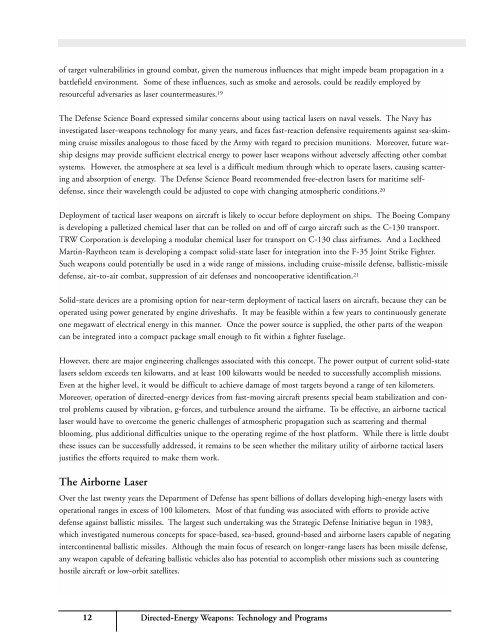directed-energy-weapons
directed-energy-weapons
directed-energy-weapons
Create successful ePaper yourself
Turn your PDF publications into a flip-book with our unique Google optimized e-Paper software.
of target vulnerabilities in ground combat, given the numerous influences that might impede beam propagation in abattlefield environment. Some of these influences, such as smoke and aerosols, could be readily employed byresourceful adversaries as laser countermeasures. 19The Defense Science Board expressed similar concerns about using tactical lasers on naval vessels. The Navy hasinvestigated laser-<strong>weapons</strong> technology for many years, and faces fast-reaction defensive requirements against sea-skimmingcruise missiles analogous to those faced by the Army with regard to precision munitions. Moreover, future warshipdesigns may provide sufficient electrical <strong>energy</strong> to power laser <strong>weapons</strong> without adversely affecting other combatsystems. However, the atmosphere at sea level is a difficult medium through which to operate lasers, causing scatteringand absorption of <strong>energy</strong>. The Defense Science Board recommended free-electron lasers for maritime selfdefense,since their wavelength could be adjusted to cope with changing atmospheric conditions. 20Deployment of tactical laser <strong>weapons</strong> on aircraft is likely to occur before deployment on ships. The Boeing Companyis developing a palletized chemical laser that can be rolled on and off of cargo aircraft such as the C-130 transport.TRW Corporation is developing a modular chemical laser for transport on C-130 class airframes. And a LockheedMartin-Raytheon team is developing a compact solid-state laser for integration into the F-35 Joint Strike Fighter.Such <strong>weapons</strong> could potentially be used in a wide range of missions, including cruise-missile defense, ballistic-missiledefense, air-to-air combat, suppression of air defenses and noncooperative identification. 21Solid-state devices are a promising option for near-term deployment of tactical lasers on aircraft, because they can beoperated using power generated by engine driveshafts. It may be feasible within a few years to continuously generateone megawatt of electrical <strong>energy</strong> in this manner. Once the power source is supplied, the other parts of the weaponcan be integrated into a compact package small enough to fit within a fighter fuselage.However, there are major engineering challenges associated with this concept. The power output of current solid-statelasers seldom exceeds ten kilowatts, and at least 100 kilowatts would be needed to successfully accomplish missions.Even at the higher level, it would be difficult to achieve damage of most targets beyond a range of ten kilometers.Moreover, operation of <strong>directed</strong>-<strong>energy</strong> devices from fast-moving aircraft presents special beam stabilization and controlproblems caused by vibration, g-forces, and turbulence around the airframe. To be effective, an airborne tacticallaser would have to overcome the generic challenges of atmospheric propagation such as scattering and thermalblooming, plus additional difficulties unique to the operating regime of the host platform. While there is little doubtthese issues can be successfully addressed, it remains to be seen whether the military utility of airborne tactical lasersjustifies the efforts required to make them work.The Airborne LaserOver the last twenty years the Department of Defense has spent billions of dollars developing high-<strong>energy</strong> lasers withoperational ranges in excess of 100 kilometers. Most of that funding was associated with efforts to provide activedefense against ballistic missiles. The largest such undertaking was the Strategic Defense Initiative begun in 1983,which investigated numerous concepts for space-based, sea-based, ground-based and airborne lasers capable of negatingintercontinental ballistic missiles. Although the main focus of research on longer-range lasers has been missile defense,any weapon capable of defeating ballistic vehicles also has potential to accomplish other missions such as counteringhostile aircraft or low-orbit satellites.12 Directed-Energy Weapons: Technology and Programs


